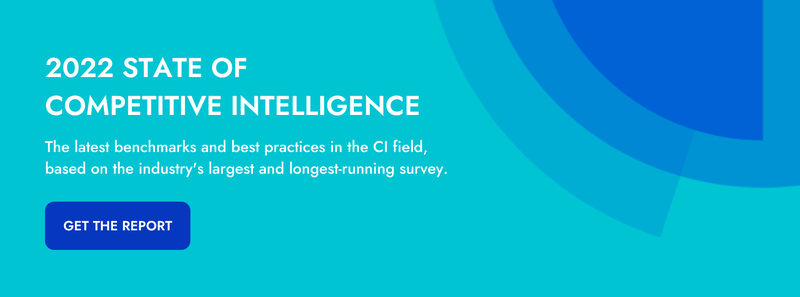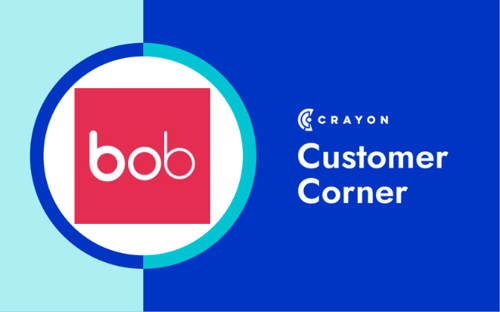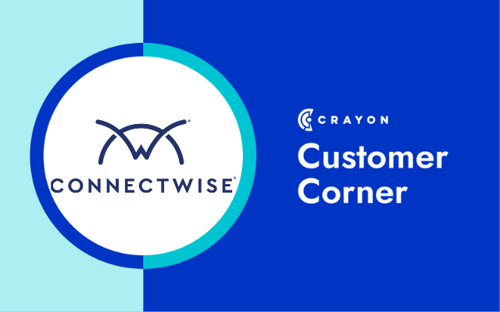In our first installment of the Crayon Customer Corner, we sat down with Carolyn Klinger, Director of Market and Competitive Intelligence at Affinity. Carolyn recently purchased Crayon for the second time, but that’s not the primary reason we wanted to chat with her. As someone who has led CI and market intelligence initiatives at several fast-growing companies, we wanted to learn more about successful CI analysis from Carolyn and how she provides exceptional analysis to get results.
1. You have a background in government intelligence, how did you transition over to competitive intelligence in the B2B space?
Upon graduating from college, I started my career in government intelligence where my team was responsible for studying leaders from around the world. I focused on one country specifically and was tasked with collecting all-source information and reporting key insights to officials at the highest levels of the United States government. While I enjoyed that experience (and the International Relations-focused master’s degree I obtained at the time), I decided to take my skills a step further and went back to school to receive another masters degree in International Marketing.
With that foundation, I joined a market research company and eventually found myself working for B2B technology companies in their competitive and market intelligence teams. While I enjoy the challenge of analyzing data, over the past decade I have found myself increasingly interested in the intersection of competitive and market intelligence with customer intelligence, leveraging all three specialties to better understand the external environment, increase win rates, and improve the overall customer and buyer experience.
2. With government intelligence, you were working on a lot of analysis once you had the right data. This obviously applies to the CI work you’ve been leading for companies. What analysis skills did you apply from your years in government to B2B competitive intelligence?
Thinking back, there are a plethora of transferable skills between government intelligence and corporate intelligence, but one that readily stands out is the ability to write concisely based on deep analyses. Both the public sector and private industry require concise writing—while still sharing key insights—for busy executives who are in a hurry to finish reading.
To be successful, the analyses must pull together disparate information, identify data patterns and trends, and be shared in brief, easy-to-understand language. This is a skill I’ve developed over time and one that can be challenging to master. There’s a difference between simply reporting what is happening and actually analyzing and synthesizing the intelligence, making informed judgments, drawing conclusions, and sharing those insights with key decision makers.
3. Your experience includes market intelligence as well. Can you walk me through how you effectively layer in market intelligence for stakeholders looking to learn more about the competitive landscape?
For a broader picture of what’s going on in the external landscape, market intelligence is key. For example, because I've been in the technology sector for most of my career, I consistently maintain a pulse on technology developments, such as new processes and ways of achieving better results, which often result in disintermediation for traditional firms. It’s important to know what’s driving customers to consider new ways of doing business, including utilizing artificial intelligence (AI), machine learning (ML), and natural language processing (NLP), and integrating those updates in a thoughtful and timely manner to key stakeholders throughout the organization.
Strategic thinkers must also answer questions such as, “How are these broad trends impacting customers and competitors?” and “What are we doing or what should we be doing to help our organization advance in the market? What blind spots exist that we haven’t addressed? What are the best ways to close those gaps?”. These insights are layered into the analyses, providing more context about what’s going on in the industry and informing how we report about developments of greatest interest to buyers and prospects that will, in turn, translate into updates to strategic planning and roadmap development.
4. Any core pieces of advice or tips you have for fellow CI practitioners on how to better analyze competitive intel?
Competitive intelligence practitioners can utilize a variety of different tools and techniques to understand their organization’s external environment. I encourage teams to think creatively about ways to uncover new sources of information, sometimes utilizing insights that are right in front of us. For example, when analyzing competitor performance, body language can uncover a lot and is a commonly overlooked strategy by many CI practitioners. By identifying patterns in body language, we can evaluate whether someone’s demeanor is actually corresponding with the words they’re using, which can demonstrate their level of confidence and expertise in a subject.
One concrete example would be a media interview with a competitor’s CEO. Chances are that this individual has been well prepared and practiced for the interview. However, if the leader begins to use body language that is out of sync with their statements, or if they use different patterns in their speaking style or unnecessary filler words, this could indicate a lack of confidence, or even hesitancy, in their response. This, in turn, could reflect possible concerns the individual may have about their product strategy or long-term roadmap.
5. As a second-time Crayon buyer and user, (woohoo!), what gets you most excited about the platform?
Two of my favorite features of Crayon are the daily digest emails and the saved search function. Every day, the platform pushes the most important insights (based on my settings and saved searches) to my email. As a CI practitioner, it’s a challenge to keep up with the fire hose of news and information coming from multiple competitors, including competitors’ website changes, press releases, case studies, financial filings, and so on. Having the most critical insights pushed to me directly, without having to enter the platform, is invaluable when juggling numerous deliverables and meetings.
The saved search function is also a critical component as it updates the most important intel in real-time and helps me categorize which content and information is most important to me. With so much data out there, Crayon helps me dial in on the intel that is most relevant to what I’m looking for at a specific point in time. In turn, these features allow me to focus on providing strategic value to my company rather than sifting through hundreds of insights to uncover key takeaways for my internal stakeholders.

Related Blog Posts
Popular Posts
-
 The 8 Free Market Research Tools and Resources You Need to Know
The 8 Free Market Research Tools and Resources You Need to Know
-
 6 Competitive Advantage Examples From the Real World
6 Competitive Advantage Examples From the Real World
-
 24 Questions to Consider for Your Next SWOT Analysis
24 Questions to Consider for Your Next SWOT Analysis
-
 How to Create a Competitive Matrix (Step-by-Step Guide With Examples + Free Templates)
How to Create a Competitive Matrix (Step-by-Step Guide With Examples + Free Templates)
-
 How to Measure Product Launch Success: 12 KPIs You Should Be Tracking
How to Measure Product Launch Success: 12 KPIs You Should Be Tracking





